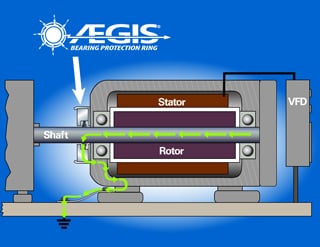Learn About Electrical Bearing Damage and How to Prevent It... While Enjoying Lunch on Us!
Lunch-and-learn presentations should be educational, not simply promotional. To benefit those who commit their time to them, lunch-and-learns should address topics that are not well understood and should provide the latest information on them as well as solutions to problems. And we know from experience that shaft voltages and the damage they can cause to motor bearings result in unplanned, unwanted, and expensive downtime. So, learning why they occur and how to prevent them is critical to design engineers and to plant maintenance people.
The problem is that the damage caused by VFD-induced shaft currents manifests itself as physical damage. And all too often those who deal with such damage assume it was caused by poor shaft alignment, inadequate lubrication, or other physical factors.
When a variable frequency drive (VFD or inverter) is used to control a motor, it alters the waveform of the power to the motor. VFDs change balanced sine wave power into a series of unbalanced positive and negative pulses that create capacitively coupled common mode voltage on the shaft of the motor. Without a low resistance path to ground, this voltage will discharge through the motor's bearings. These voltage discharges cause electrical discharge machining in the form of pitting (tiny fusion craters in metal surfaces), frosting (widespread pitting), and fluting (washboard-like ridges in the walls of the bearing race resulting from the operational frequency of the VFD).
Without proven long-term bearing protection, these discharges can destroy motor bearings — often in as little as 3 months!
At AEGIS®, we have been educating motor users, motor repair shops, plant maintenance personnel, specifying engineers, and contractors on the causes and prevention of electrical bearing damage for years. And through the years we have come across more than a few products that claim to protect against electrical bearing damage, but don't actually live up to these claims. We know what works and what doesn't. And because we have tested them, we can tell you where and how they fall short.
We have also developed best practices for diagnosing electrical bearing damage and preventing it in motors large and small, low or medium voltage. We have even detailed these best practices in a 56-page Bearing Protection Handbook that discusses in detail the causes of electrical bearing damage, how to diagnose it, and step-by-step best practices for protecting motors from it.
Yet, despite these efforts to inform and educate motor users, we still find many who are unaware that the problem even exists or are unsure why or how to address it.
So if you would like to learn about the causes of electrical bearing damage and best practices for preventing it, we have a 1-hour presentation on the subject. And we would welcome the opportunity to make this presentation to as many of your people as you would like — from a handful to a room full — at whatever time you like. We'll even bring lunch or other refreshments.
To request a Lunch-and-Learn training at your facility, click here.


